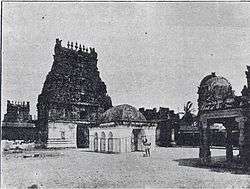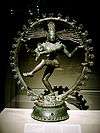Kayarohanaswami Temple, Nagapattinam
| Kayarohanaswami Temple | |
|---|---|
|
| |
 Kayarohanaswami Temple Location in Tamil Nadu | |
| Geography | |
| Coordinates | 10°46′13″N 79°50′26″E / 10.77028°N 79.84056°ECoordinates: 10°46′13″N 79°50′26″E / 10.77028°N 79.84056°E |
| Country | India |
| State | Tamil Nadu |
| District | Nagapatnam |
| Location | Nagapatnam |
| Culture | |
| Primary deity | Kayarohanaswami(Shiva) |
| Architecture | |
| Architectural styles | Dravidian architecture |
The Kayarohanaswami Temple is a Hindu temple dedicated to Lord Siva situated in the town of Nagapattinam in Tamil Nadu, India. The presiding deity is known as Kayarohana and his consort is Nilayathakshi.[1] The temple has been in existence from the 6th century AD and has been praised by the Nayanmars Appar, Sambandar and Sundarar.[2] The temple has been constructed by the Lakolisa cult which originated in Gujarat and their only other temple in Tamil Nadu is at Kanchipuram.[2] The idol of Thyagaraja in the temple is made of lapis lazuli.
Etymology

Karona is a corruption of Kaya-rohana(kayam:body, arohana:raising) and the temple is the twin of Kayarohana temple in Gujarat. Karonam might also have been derived from other origin such as "Kar Onam" and Lord Vishnu has been referred as "Onathan". The temple has been rebuilt by the Pallavas and Cholas.[3]
Processional Dance
The Thyagarajar Temple at Tiruvarur is famous for the ajapa thanam (dance without chanting), that is executed by the deity itself. According to legend, a Chola king named Mucukunta obtained a boon from Indra(a celestial deity) and wished to receive an image of Thyagaraja Swamy(presiding deity, Shiva in the temple) reposing on the chest of reclining Lord Vishnu. Indra tried to misguide the king and had six other images made, but the king chose the right image at Tiruvarur. The other six images were installed in Thirukkuvalai, Nagapattinam, Tirukarayil, Thirunallar, Thiruvaimur and Tirumaraikadu.[4] All the seven places are villages situated in the river Cauvery delta. All seven Thyagaraja images are said to dance when taken in procession(it is the bearers of the processional deity who actually dance). The temples with dance styles are regarded as Saptha Vidangam(seven dance moves)[5] and the related temples are as under:[6]
| Temple | Vidangar Temple | Dance pose | Meaning |
| Thyagarajar Temple | Vidhividangar | Ajabathaanam | Dance without chanting, resembling the dance of Sri Thyagaraja resting on Lord Vishnu's chest |
| Dharbaranyeswarar Temple | Nagaradangar | Unmathanathaanam | Dance of an intoxicated person |
| Kayarohanaswamy Temple | Sundaravidangar | Vilathithaanam | Dancing like waves of sea |
| Kannayariamudayar Temple | Adhividangar | Kukunathaanam | Dancing like a cock |
| Brahmapureeswarar Temple | Avanividangar | Brunganathaanam | Dancing like a bee that hovers over a flower |
| Vaimoornaathar Temple | Nallavidangar | Kamalanaanathaanam | Dance like lotus that moves in a breeze |
| Vedaranyeswarar Temple | Bhuvanivividangar | Hamsapthanathaanam | Dancing with the gait of a swan |
References
- ↑ P. V. Jagadisa Ayyar (1920). South Indian shrines: illustrated. Madras Times Printing and Pub. Co. pp. 389–391.
- 1 2 Tourist Guide to Tamil Nadu. Sura Books. p. 72. ISBN 81-7478-177-3, ISBN 978-81-7478-177-2.
- ↑ Nagapattinam to Suvarnadwipa: reflections on Chola naval expeditions to South east Asia.P.107.Hermann Kulke, K. Kesavapany, Vijay Sakhuja
- ↑ Glimpses of the history of Karaikkal.Saroja Sundararajan
- ↑ The Journal of the Music Academy, Madras: Volumes 33-34 .Music Academy (Madras, India) - 1962
- ↑ Nityasumaṅgalī: devadasi tradition in South India .P.146. Saskia C. Kersenboom-Story
External links
| Wikimedia Commons has media related to Kayarohanaswami Temple, Nagapattinam. |

